|
Cold War Warriors The Silent Service during the Cold War - Part 3
Captain William Hicks, USN Ret.
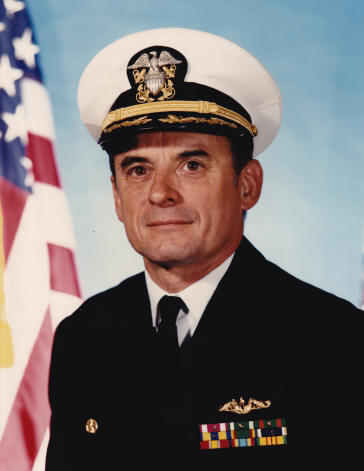
Read Part 2
Submarine Squadron Engineer, New London Connecticut
Submarine Squadron Two (SUBRON 2) was located at the Submarine Base New London, Groton CT. The squadron consisted of three Divisions—two with 6 or 7 diesel submarines each and one with five disparate. nuclear ships. The Nuclear Division had been formed a couple months before my arrival and I was the first nuclear qualified Squadron Engineer at SUBRON
2. When I arrived, the nuclear ships included: USS Nautilus, SSN 571, the first nuclear submarine and much the worse for the years of wear; USS Skate SSN 578, the first unit of the class that included Sargo. Skate had also been operated hard and was ready for overhaul; USS Narwhal SSN 671 (an SSN with a unique, one of a kind reactor plant that operated with natural
circulation for improved noise reduction); USS Archerfish SSN 678 which had just completed new construction and was soon transferred out of SUBRON 2 and replaced by USS Tullibee SSN 597 which was a small ASW submarine with a unique reactor and electric-drive, propulsion plant and the first, large ball, bow-mounted sonar;
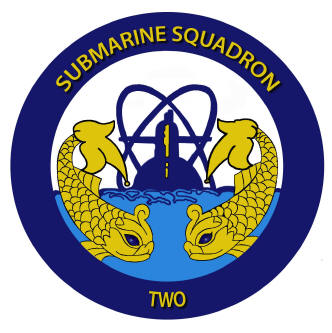 The final nuclear unit of SUBRON 2 was designated Submarine NR1- a small nuclear powered deep submersible which operated with 3 officers and 8 enlisted operators. As a result, I was the Squadron Engineer for five going on seven different reactor plants and several units that had special importance
to Admiral Rickover that meant we received more than our share of "help". The diesel submarines were veterans of WWII that had received significant upgrades such as additional batteries, enhanced sonar and weapons systems, and submerged snorkel capability. They also had a lot of miles under their keels and were a different kind of maintenance challenge. The final nuclear unit of SUBRON 2 was designated Submarine NR1- a small nuclear powered deep submersible which operated with 3 officers and 8 enlisted operators. As a result, I was the Squadron Engineer for five going on seven different reactor plants and several units that had special importance
to Admiral Rickover that meant we received more than our share of "help". The diesel submarines were veterans of WWII that had received significant upgrades such as additional batteries, enhanced sonar and weapons systems, and submerged snorkel capability. They also had a lot of miles under their keels and were a different kind of maintenance challenge.
Duties of a Squadron Engineer
My responsibilities as Squadron Engineer were in three basic areas: Maintenance of the assigned submarines. I acted as an interface between the ships and the Intermediate Maintenance Activity (IMA) that for SUBRON 2 was the Submarine Base. I also acted as advisor and source of information for the ships commanding officers and engineers. From my
position I had access to technical resources that were not readily available to the ships. I also had my previous experience as a ship engineer to draw from.
My second area or responsibility involved training and oversight with emphasis on nuclear propulsion plant operations. I went to sea with the ships during training periods to assist with keeping up the crew’s operational proficiency. I also conducted inspections and surveillance both in port and at sea.
Finally, I was qualified and acted as the squadron duty officer who had a bit of everything for which the squadron staff was responsible from operational orders to weapons movements to engineering casualties and maintenance progress. Every duty day was different and each was a challenge. The most significant difference to me between my responsibilities
as a Squadron Engineer and a ship’s engineer was that in the Squadron I dealt with the challenging issues and hard problems and generally could avoid the minutiae of day to day ship operations. The hours were also a bit less, but I still spent time at sea, and when a problem arose, I was frequently at the base late into the night.
Transfer of WWII subs to Foreign Navies
I will now discuss some of the more interesting events and activities in which I was involved during my three years (10/71-10/74) as the Squadron Engineer of SUBRON 2.
The defense budget was shrinking to accommodate the post - Vietnam period and the nuclear submarine force was expanding with new construction deliveries, such that it was necessary to downsize the diesel submarine force through decommissioning.
The first step was for the Bureau of Inspection and Survey (INSURV) to inspect the submarines with the minimum standard for the inspection being nuclear propulsion which obviously all the diesel submarines failed and were recommended for removal from the active force. Almost without exception, the INSURV report commented on the excellent material
condition of each submarine they were recommending to be scrapped. This situation opened the way for transfer of these submarines to friendly foreign navies.
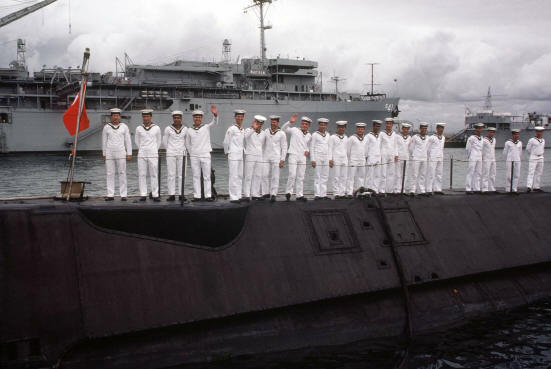
Turkish sailors man the rail aboard the Hizirreis (S-342) ex- USS Gudgeon (SS-567)
at the conclusion of the transfer ceremony.
During my time at CSS 2 we decommissioned and transferred 14 diesel submarines to foreign navies. This resulted in many memorable and interesting stories. The nations that received the submarines included Turkey, Greece, Italy, Spain, Brazil, Taiwan, Venezuela, and possibly some others. We frequently had more than one foreign crew at the Submarine Base
at the same time. At one point there was a Greek Crew on one side of a pier and a Turkish Crew on the other. Someone posted a sign at the head of the pier: Cyprus. However, the crews did not mind and showed no animosity towards each other.
The sequence for the transfers followed a predictable pattern. The decision would be made to decommission the submarine and a foreign recipient would be identified in Washington. Dates would be set and the foreign crew would arrive in New London to become familiar with the ship and possibly receive training at the Submarine School. After an appropriate
period that differed depending on the experience of the receiving crew and other diplomatic decisions with which we had no input, the submarine was decommissioned by the U.S. Navy and immediately commissioned into the foreign navy - usually with significant ceremony including the presence of senior, foreign military and diplomatic personnel.
Following commissioning into the foreign navy, we assigned a Military Training Team (MTT) to the submarine to assist the crew in gaining competence in submarine operations. The MTT usually consisted of about 6-10 enlisted ex-crew members and one officer who had served on the submarine at the time of decommissioning. The MTT duration of service depended
on the experience and competence of the new crew and the desires of the receiving nation. The durations extended from weeks in the neighborhood of New London to months ending when the submarine had transited to it’s home country. The MTT teams had many adventures including attempts to submerge with hatches open to observing standards of discipline that were more severe than
permitted by the US Navy. In the case of the Taiwan submarine, the term "Chinese fire drill" took on new meaning.
As the Squadron Engineer, I had limited contact and responsibility with the foreign crews and MTT teams. My one area of responsibility involved maintenance both before and after the transfer. Maintenance before was our responsibility and the foreign navy was anxious that all required maintenance be completed prior to their accepting responsibility for
the submarine. This resulted in several tense, late-night efforts to get the job done before the turnover date. Following the transfer, the maintenance could be done by our IMA, but must be paid for by the foreign navy. In one interesting situation, a unit was in New London longer than usual awaiting assignment to a shipyard for major maintenance. The commanding officer had a
long list of maintenance task he wanted us to do prior to his arrival at the shipyard. In order to fund the maintenance, he had a cigar box full of US Currency in his stateroom. Several days a week, one of my assistants would meet with the captain; discuss the jobs he wanted done; agree on the price for the work and parts and payment in cash would occur. The cash was
transferred to the Squadron Supply Officer for deposit into U.S. Navy accounts.
WWII Submarine Disposal

Line up of decommissioned subs at Groton, CT., circa 1947. From left to right: Archerfish (SS-311), Flasher (SS-249), Cobia (SS-245), Croaker (SS-246), Drum (SS-228)
& what looks like the Cavalla (SS-244).
The diesel submarines were approaching the end of their useful life and the availability of parts to maintain them was a challenge. Following WW II, a number of diesel submarine reserve units were established in various ports that included a diesel submarine that was used for training of the reserve crews. The reserve submarines never went to sea, but
selected systems remained operational and were exercised and maintained by the reserve units.
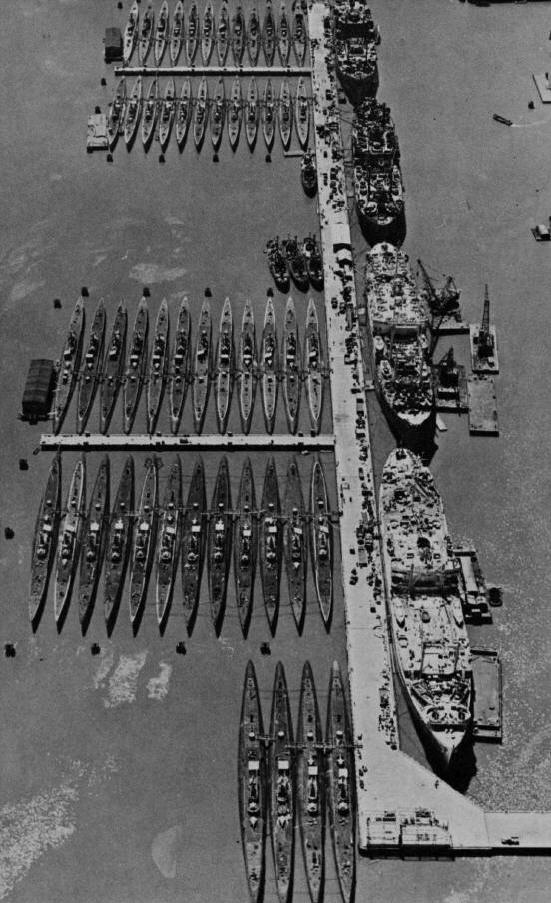
At the end of WWII, a vast majority of US submarines were retired.
In this photos alone, 52 submarines and 4 submarine tenders are shown
in the US Navy Reserve Fleet, Mare Island Naval Shipyard, California, circa Jan 1946
About 1970, the decision was made to scrap the reserve submarines. The active submarine force was given the opportunity to enter the discussion regarding how the scrapping should be handled. Some of the submarines to be scrapped were similar to those we were operating. All the submarines still had many of their spare parts aboard.
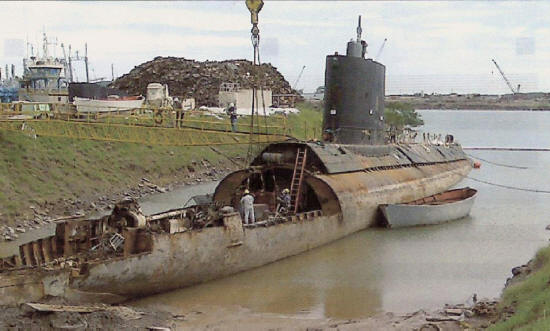
Scrapping of USS Trout (SS-566) in Brownsville, Texas.
The outcome for CSS 2 was that we took custody of two reserve submarines and removed the spare parts from several others. Thus we had a source of repair parts and components to assist in maintaining our operating submarines. This mitigated two problems: the cost of maintaining our diesel fleet and the availability of spare parts and components. This
became known as our "strip ship operation".
The submarines we stripped were the ex USS Carp SS 338 and ex USS Croaker SS 246. We used temporary-duty and medical hold submarine sailors to man and manage the "strip ship operation". We took over a warehouse on the Submarine Base to store and inventory the spare parts. Some items were removed from the submarines, but most of the items remained on
the ship until a need was identified at which time they were removed—usually by the crew that wanted the material. We attempted to keep track of the material we salvaged including the value.
At the end of two years, we had documented over $2 million in savings, but more importantly we provided parts that were no longer available in the supply system. The effort was critical to the readiness of our diesel submarines during the last couple years of their operations. It should also be acknowledged that while we made an effort to ensure that
the parts were compatible and of consistent quality certification with the submarines upon which they were being installed, we did have a few "ah shucks" moments like when one crew decided to replace a hatch from a "strip ship" only to determine that while it looked compatible - when they submerged it leaked. That event caused a tightening of the quality evaluation and
documentation when we were dealing with hull or seawater integrity items.
"Strip ship" was not an endeavor for which my nuclear training and experience prepared me, but along with my staff, we made it work and made it successful.
Nuclear Deep Submersible Research Submarine
Submarine Number 1, a.k.a. NR1 was a small, nuclear powered deep submersible research submarine. NR1’s propulsion was provided by two external electric motors that provided a capability for speeds of only a couple of knots which was adequate for deep submergence research but not very effective for transit. Thus, NR 1 was always towed or ferried from
port to the area of operation.
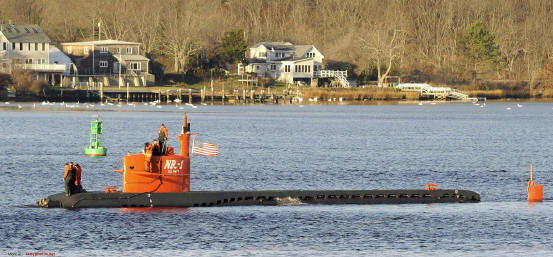
NR1
For routine operations, NR1 was towed by a submarine rescue ship (ASR). Later, the ASR was replaced by a commercial surface towing craft. For more secure transportation, NR1 could be towed by a submerged submarine which required some unique modifications to the towing submarine and some skillful, submerged maneuvers to connect the tow. Finally, NR1
could be ferried on an amphibious transport that also required some unique and skillful maneuvers and reactor operations.
NR1 was of particular interest to Admiral Rickover, so we had lots of help and interest in its routine operations and maintenance. NR1 had a unique, silver-alkaline battery design with more power-density that required unique procedures to charge and maintain it. One night following a routine battery charge, I got a call at home that suggested I return
to the base since there was a fire aboard NR1. The fire was in the battery compartment that was under the only access hatch and between the shutdown reactor operator (SRO) and the exit hatch. NR1 rapidly filled with smoke and noxious gas. The SRO had air - fed breathing capability and reported that he was not in immediate jeopardy. He remained at his station monitoring the
shutdown reactor.
Since the fire was in the battery well, water could not be used. CO2 fire extinguishers were the choice. We expended all the CO2 extinguishers we could get at Submarine Base and requested additional from State Pier. The CO2 was cooling the battery well, but the fire was not extinguished since it was being maintained by the battery contents without need
for external oxygen. It appeared the only option was to let it burn out by consuming all the available fuel in the battery. Concern was raised when it became apparent that the NR1 air supply could not continue to support the SRO indefinitely. This caused a call to a ship at the next pier to string an air hose from their air breathing system to NR1.
Once that was accomplished, the situation was sustainable, but until the fire burned out and the level of contamination in the air could be determined, the SRO had to stay in the air-line mask. With the ability to cool the battery well with the CO2 extinguishers, it was possible to relieve the SRO. After about six hours, the fire burned out and the
planning began for the recovery.
NR1 was supported by the Electric Boat Shipyard where it was built and by an electronics vendor who had provided the research and sensor equipment on the ship. Both organizations as well as resources at the Submarine Base were brought into the effort to plan and execute the recovery from the fire. Because of the interest from Admiral Rickover, the
effort received more emphasis and energy than might have been appropriate for a research vessel.
The assessment following the NR1 fire identified the obvious. That the battery required replacement and the battery - well required repairs. The surprise finding was the high level of mercury contamination on every surface inside NR1. Mercury is prohibited on submarines due to the corrosive effect on some of the submarine seawater - system materials.
However, there had been a waiver from that requirement when it was determined that trace amounts of mercury were required in the silver alkaline battery. During the fire, the mercury in the battery had vaporized and subsequently deposited on all materials and surfaces. Airborne mercury was also a hazard to the crew if ingested at above normal? threshold amounts. Investigation
found that the mercury was absorbed in insulation and coated all surfaces. Removal could be accomplished by wiping the accessible surfaces but to remove the remaining mercury, it was determined that heat could be used to evaporate the mercury which could be removed by changing the air.
A cleaning facility for the electronic drawers and modules as well as removable components was established in an unused building. The entire submarine was brought to an elevated temperature and air exchanged to remove mercury from within the hull. The cleanup seemed to be on track. During this event, I learned a lot about things I had never considered.
There were few options in portable instrumentation to measure low levels of atmospheric mercury. Iodized activated charcoal would remove airborne mercury, but that was not an item available within the supply system and there was no way to place it into the N 1 ventilation system. Ultimately, we got the battery replaced, most of the mercury removed, and enough iodized charcoal
ventilation units installed to keep the atmospheric mercury levels low enough for crew safety. Especially for future, extended periods of submerged operations. NR1 was ready for sea again.
Read part 4
Read other articles by Captain William Hicks
Read other Cold War Warrior
Articles
|